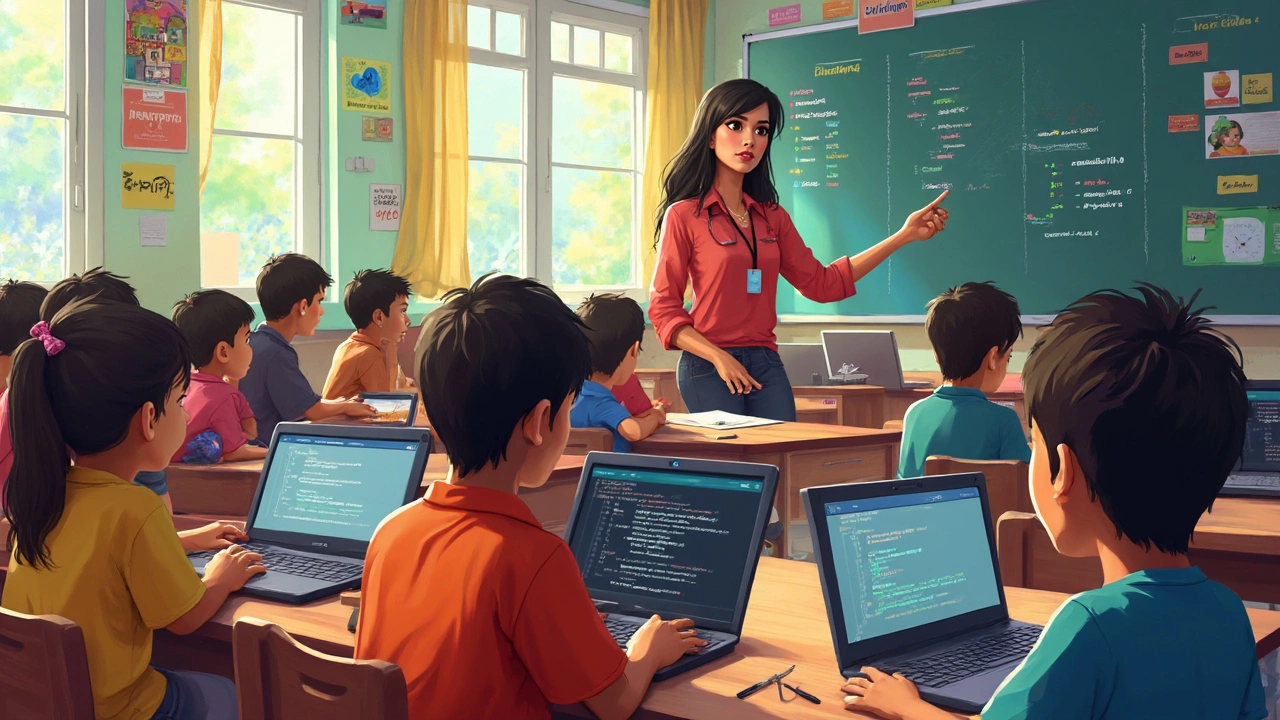
When my son Rishabh wanted to learn to code, I spent hours digging through reviews, demo courses, and forums. The amount of choices was honestly overwhelming—websites promising you'll be a coding wizard by next weekend, local centers with robots on their flyers, and more YouTube gurus than you can count. If you’re in the same boat, you’re not alone.
The toughest part isn’t finding a coding class; it’s picking the right one. Not all classes fit every learner, budget, or schedule. Some focus on making games, others on websites, and some just throw jargon at you and hope you magically get it. Let’s clear up what actually matters when choosing so you don’t waste time or cash.
- What Makes a Good Coding Class?
- Top Options for Kids and Beginners
- Online vs. In-Person: Pros and Cons
- How to Choose the Right Course for You
What Makes a Good Coding Class?
If you just Google coding classes, you’ll get hit with a million options. But only a handful actually help you code smarter—not just faster. The secret sauce? Good classes do more than throw videos at you. They keep you hooked, give you support when you’re stuck, and build your skills step by step.
Here’s what to look for if you’re picking a coding class for yourself or your kid:
- Real Projects: Classes that have you make actual apps or games, even simple ones, make sure you're really learning. Watching someone else code is not the same as doing it yourself.
- Step-by-Step Path: Does the class start with basics and then build up? Classes without some sort of level system can leave you lost.
- Active Support: Live help, chat groups, or easy contact with a teacher means you’re not stuck Googling random bugs for hours. This is huge for beginners.
- Updated Material: Coding changes fast. Make sure the class teaches stuff people actually use in companies today. For example, Python and JavaScript are top picks in 2025 job posts, while older tutorials might stick you with outdated tools.
- Fun Factor: Especially for kids, “fun” isn’t just about cartoons. It means lots of hands-on play—like learning loops by programming a robot to dance.
Online reviews and demo lessons tell you a lot. I always check Reddit, parent Facebook groups, and the actual preview videos before whipping out a credit card.
| Must-Have Feature | Why It Matters |
|---|---|
| Project-Based Learning | Builds confidence and real experience |
| Step-by-Step Levels | Prevents overwhelm, keeps you improving |
| Interactive Help | Gets you past roadblocks fast |
| Relevant Languages Taught | Prepares you for current jobs |
| Clear Progress Tracking | Shows you (and your kid) how far you’ve come |
Every good class mixes fun, clear teaching, and support. If it ticks these boxes, you’re more likely to actually finish the course—and actually remember what you learned.
Top Options for Kids and Beginners
If you’re hunting for the best coding classes for kids or total beginners, ignore the hype and watch for programs that actually get people hands-on with real projects. For younger kids (ages 6-12), Scratch is a game-changer—it uses blocks to drag and drop code, and it’s backed by MIT, so you know it’s legit. Scratch lets kids make their own games with colorful art and easy-to-follow explanations. It’s also free, and there are tons of tutorials on their site.
For kids a bit older or more ambitious, Code.org’s “Hour of Code” sessions are everywhere in schools and online. They introduce block coding, logic puzzles, and even Minecraft themes that keep things fun. Tynker is another good one—lots of my son’s friends swear by it for the neat way it explains coding basics.
- Scratch: Great for first-timers, visual, totally free.
- Code.org: Strong mix of fun and foundational skills, easy to use, and trusted in schools.
- Tynker: Good for progressive learning, paid but has some free starter content.
For teens and adults, jumping into HTML, Python, or JavaScript is smart. Websites like Codecademy and freeCodeCamp let you build projects right in your browser. Codecademy gives nice bite-sized lessons, so you won’t feel lost. freeCodeCamp is tougher but gets you building stuff that actually works, like portfolio websites.
- Codecademy: Junior and adult-friendly, interactive, some free tracks, paid for full access.
- freeCodeCamp: Totally free, lots of community help, direct project-building.
One thing: avoid classes that only show videos without practice. Real progress happens when you write code, break things, and fix them. The best classes give you stuff to actually build, not just watch.

Online vs. In-Person: Pros and Cons
If you’re stuck choosing coding classes online or in-person, you're basically picking between flexibility and hands-on help. Both have real upsides (and some drawbacks) you should know about before dropping any cash.
Online classes are all about learning on your own schedule. Platforms like Codecademy, Khan Academy, and Coursera let you fit lessons around school, work, or even just family movie nights. Got stuck on a problem at 1 a.m.? No big deal—you can watch example videos and practice whenever you like. Some sites, like freeCodeCamp, are even 100% free. The big catch? Without regular check-ins, a lot of people struggle to stay motivated. There’s no one to notice if you slack, so unless you keep yourself on track, progress can stall fast.
In-person classes, like those at Code Ninjas or local community centers, give you a group and a teacher right there. If you ask my son Rishabh, nothing beats a teacher stepping in when Python refuses to cooperate. You get live answers, teamwork, and sometimes even actual robots or hardware to mess around with. The obvious drawback is fitting it into your weekly schedule and, honestly, it’s usually pricier—especially for the good ones.
| Feature | Online Classes | In-Person Classes |
|---|---|---|
| Cost | Often free to $40/month | $80–$200/month |
| Scheduling | Self-paced | Fixed times |
| Peer Interaction | Mostly forums or chats | Face-to-face, small groups |
| Immediate Help | Limited (email/chats) | Instant, in-person |
| Hands-on Projects | Usually virtual only | Often includes physical projects |
Here are a few tips for picking what fits you (or your kid) best:
- If balancing school or work is tough, online classes keep things flexible.
- Need someone to push you or answer questions live? In-person is worth it.
- Pay attention to travel time and commuting if you’re considering in-person lessons.
- If your goal involves building stuff like robots or circuits, in-person almost always wins.
Sometimes a mix, like joining a virtual class with live instructors, combines both worlds. The right choice depends on how you (or your kid) learn best and what keeps you motivated over time.
How to Choose the Right Course for You
Choosing the right coding class feels like picking from a never-ending buffet. You want value, a course that matches your style, and real skills you can use. Here’s how to make that call without second-guessing yourself later.
Start by figuring out your goal. Want to build games, launch a website, or just understand what your kid is learning in school? Each path needs its own kind of class. For example, basics like HTML, CSS, and JavaScript are perfect if you’re interested in web stuff, while Python is usually friendlier for beginners and is used everywhere from data science to automation.
Next, think about the way you learn best. Are you the type who buzzes through videos alone, or do you need someone to explain stuff when you’re stuck? Self-paced online courses like Codecademy or freeCodeCamp are great for independent folks. In-person or structured online bootcamps, like those by Udemy or local coding schools, offer more hand-holding and feedback. And get this—studies show that students in interactive, instructor-led coding classes are 35% more likely to finish what they started compared to those who learn only by themselves.
Also, don’t ignore the “try before you buy” principle. Loads of top coding classes let you sample their lessons. This gives you a sense for the vibe, difficulty, and teacher support without dropping a cent. My son, for example, liked Code.org’s drag-and-drop interface way more than text-heavy platforms when he started.
Prices are all over the map. You can find free courses or pay a few hundred dollars for a bootcamp. Here’s a quick table comparing some popular options:
| Platform | Best For | Cost | Live Support |
|---|---|---|---|
| Codecademy | Beginners/Intermediate | $0–$40/month | Limited |
| Udemy | All Levels | $15–$150/course | None |
| freeCodeCamp | Absolute Beginners | Free | Community Only |
| Code.org | K-12, Young Learners | Free | No |
| Local Coding Bootcamps | Career Changers | $500–$20,000+ | Yes |
If you’re a parent picking for your kid, make sure the platform is kid-safe and uses games or challenges to keep things fun. Boring equals quitting, trust me. If you want a job after, check if the course offers certificates or direct connections to employers—which some bootcamps advertise front and center.
- Pin down your goal
- Pick a class that matches your learning style
- Sample before committing
- Balance cost with features like support, certificates, and format
- Check for reviews from real students about results
The single biggest tip? Don’t stress about finding the “perfect” option. What matters is starting and sticking with it. The best coding classes aren’t just about content—they keep you learning until coding feels natural. That’s where the magic happens.
